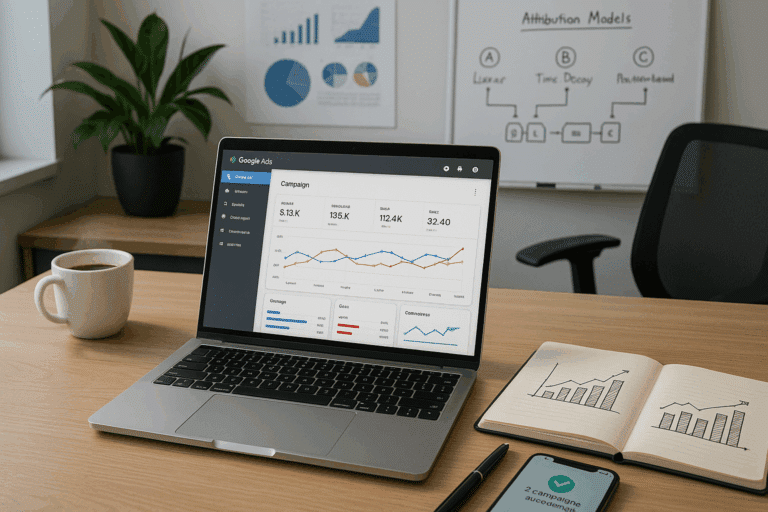The creative is brilliant, the message is clear, and your brand is ready to capture the attention of consumers. You’ve covered all your digital touchpoints – email, social media, search engine marketing, and more. But, here’s the catch! How do you track and measure the impact of offline conversions that resulted from this campaign? And, how can you optimally assign attribution to each marketing channel involved? 🤔
If you’re scratching your head, fret not. In today’s digitally-focused world, it’s all too easy to forget that many conversions still happen offline, outside the digital sphere. However, by ignoring these offline conversions, you’re potentially leaving valuable insights and ROI on the table. Tracking offline conversions and implementing effective attribution strategies are essential steps in maximizing your marketing ROI, and this article aims to be your comprehensive guide to achieving just that. 📚
Expect a deep dive into the world of offline conversions, where we’ll explore the concept, its importance, and the various methods for tracking them. We’ll then pivot to marketing attribution strategies, where you’ll discover how to accurately assign credit to different marketing channels and optimize your marketing spend. Prepare for an immersive journey that seamlessly integrates technical know-how with practical applications, all packaged in an engaging narrative. 💼
The Unveiling of Offline Conversions: Why Should You Care? 🌐
First things first, let’s understand the beast we’re dealing with. The term ‘offline conversions’ may sound counterintuitive in an age where everything is turning digital. However, offline conversions are far from obsolete. In fact, they continue to be a vital part of the marketing mix. From phone calls to in-store visits and beyond, we’ll shed light on what offline conversions are and why they are instrumental in shaping your marketing strategies. Furthermore, we’ll delve into the challenges in tracking offline conversions and provide you with effective solutions to overcome them.
Attribution Strategies Unveiled: The Art of Allocating Credit 💰
Once we have a firm grasp on offline conversions, it’s time to turn our attention to the all-important question: Which marketing channel gets the credit? This question forms the core of attribution strategies. Here, we’ll unpack different attribution models, discuss their strengths and weaknesses, and reveal how you can choose the best one for your business. Get ready to delve into the world of first-click, last-click, linear, and multi-touch attribution models, among others.
Equipped with the right attribution strategy, you’ll be able to understand the customer journey better, gain insightful data to inform future campaigns, and ultimately maximize your marketing ROI. So, buckle up as we embark on this enlightening journey to harness the full power of your marketing efforts. 🚀
By the end of this article, you’ll have a thorough understanding of how to track offline conversions and implement effective attribution strategies. You’ll be armed with the tools you need to not just survive, but thrive in the challenging landscape of marketing ROI maximization. Time to dive in and unlock the secrets of offline conversions and attribution strategies! 🗝️
Unraveling the Enigma of Offline Conversion Tracking
In the contemporary digital landscape, businesses are constantly in search of strategies to maximize their marketing return on investment (ROI). Often, they gravitate towards online marketing and conversion tracking, given its clear, quantifiable, and real-time metrics. But what about offline conversions? These are a critical part of the marketing mix that often gets overlooked. In this comprehensive guide, we delve into offline conversion tracking, its significance, and how it can contribute to a robust marketing ROI.
Offline conversion tracking entails monitoring and evaluating the efficacy of marketing efforts that lead customers to make purchases or conversions in physical stores, over the phone, or through other offline channels. It might seem like a herculean task given the inherent lack of digital footprint in these transactions. However, with the right strategies and tools, it’s entirely feasible and can provide invaluable insights to marketers.
For a comprehensive understanding of offline conversion tracking and its power, you might find it helpful to watch this YouTube video titled “Offline Conversion Tracking: What It Is and How It Works” by Salesforce. It provides a beginner-friendly explanation of the concept, making it an excellent starting point for anyone new to this marketing strategy.
The Synergy between Offline and Online Conversion Tracking
One crucial aspect that marketers often miss is the potential synergy between online and offline conversion tracking. With today’s omnichannel consumer behaviors, the boundaries between online and offline transactions are blurring. It’s not uncommon for a customer to see an online advertisement, research the product online, and then purchase it in a physical store. Hence, offline conversion tracking is not just about standalone offline campaigns. It’s about understanding the holistic consumer journey and using that knowledge to optimize marketing ROI.
The most common strategies for tracking offline conversions involve the use of unique identifiers like coupon codes, phone call tracking, or even advanced data analytics solutions. In the following section, we will dig into these strategies and provide a comparative analysis to help you choose the most suitable one for your business.
Before diving into the details, let’s watch another useful YouTube video. Titled “The Power of Omnichannel Marketing” by the HubSpot Academy, this video underscores the importance of integrating online and offline marketing efforts for a truly effective strategy.
Offline Conversion Tracking Strategies: A Comparative Analysis
When it comes to offline conversion tracking, there’s no one-size-fits-all solution. Depending on your business model, target audience, and marketing strategy, different methods may yield better results. Here, we provide a comparative analysis of the most popular offline conversion tracking strategies.
| Strategy | Pros | Cons |
|---|---|---|
| Unique Coupon Codes | Easy to implement; Clear link between online promotion and offline purchase | Limited to promotional campaigns; Can’t track customer journey beyond the use of the coupon |
| Phone Call Tracking | Tracks complete customer journey; Rich data for analysis | Requires advanced systems; Privacy concerns |
| Advanced Data Analytics | Comprehensive tracking; Enables predictive analytics | Requires significant investment; Complex implementation |
As you can see from the table, each strategy comes with its own set of advantages and limitations. The key is to find a method that aligns with your business goals and resources. To further explore these strategies, you might want to check out the YouTube video “Offline Conversion Tracking Strategies Explained” by the Digital Marketing Institute.
Decoding Attribution Models
Understanding the customer journey is only the first step. Once you’ve collected the data, the next challenge is to make sense of it. This is where attribution models come into play. An attribution model is a rule, or set of rules, that determines how credit for sales and conversions is assigned to touchpoints in conversion paths.
The choice of the right attribution model can significantly influence your perception of the effectiveness of different marketing channels. For instance, the ‘last click’ model assigns all credit to the final touchpoint before the conversion, whereas the ‘first click’ model attributes all credit to the first touchpoint.
For an in-depth understanding of attribution models and their significance, I recommend watching the YouTube video “Attribution Modeling Explained in Simple Terms” by Loves Data. This video provides an excellent explanation of the different attribution models, making it easier for you to choose the most appropriate one for your business.
Implementing Offline Conversion Tracking and Attribution Models: Best Practices
Now that we’ve covered the basics, it’s time to get into the nitty-gritty of implementing offline conversion tracking and attribution models. Here are some best practices to guide you:
- Always start with a clear objective. What do you hope to achieve with offline conversion tracking? What insights are you seeking? These objectives will guide your choice of tracking strategy and attribution model.
- Ensure privacy compliance. Regardless of the tracking method you choose, always ensure it complies with privacy laws and regulations. Transparency and respect for customer privacy are non-negotiable.
- Invest in training. Data analytics can be complex. Make sure your marketing team is well-trained to handle the tools and interpret the data.
- Continually test and refine. Like all marketing strategies, offline conversion tracking is not a set-and-forget solution. Continually test different strategies and attribution models to find the most effective combination.
For more detailed guidance on these best practices, I highly recommend watching the YouTube video “Offline Conversion Tracking Best Practices” by Marketing Land. This comprehensive guide will provide you with the knowledge and confidence to implement your own offline conversion tracking strategy.
Final Thoughts
To conclude, offline conversion tracking is a powerful tool that can significantly enhance your marketing ROI. By understanding the complete customer journey, both online and offline, you can optimize your marketing efforts and drive more conversions.
Don’t let the complexity deter you. With a clear objective, the right tools, and a solid understanding of attribution models, you can harness the power of offline conversion tracking to gain a competitive edge.
So go ahead, embark on this exciting journey, and unlock the full potential of your marketing strategy!

Conclusion
In conclusion, we have come a long way in our exploration of advanced technological concepts in IT and Engineering. This comprehensive article has been a journey through the intricate world of Software Engineering and the principles that guide it.
We have examined how software development methodologies like Agile and DevOps foster collaboration and efficiency, providing the backbone of modern software development. We’ve also seen the significant role of object-oriented programming, with its reusable code and modular approach, in simplifying complex coding processes.
Furthermore, we have ventured into the realm of data structures and algorithms, which form the foundation of efficient programming. From arrays to linked lists, from sorting to searching algorithms, we’ve seen how they optimize data management and processing.
We’ve also taken a deep dive into the world of databases, both SQL and NoSQL, highlighting their role in storing and retrieving data effectively. By discussing cloud computing, we’ve acknowledged how it has revolutionized the IT industry by providing scalable and cost-effective solutions.
However, the importance of cybersecurity was not undermined as we explored various security threats and the measures to counter them, emphasizing the need for a robust security system in this digitally connected world.
In essence, the world of IT and Engineering is continuously evolving, with new technologies emerging and old ones being improved upon. The breadth and depth of knowledge required in these fields are immense, and it is crucial to stay updated and continually learn.
Therefore, I encourage you to delve deeper into these subjects, apply these concepts in your daily work, and share your experiences with your colleagues and peers. Please feel free to comment and share your thoughts or questions about any of the topics discussed in this article.
This journey has only just begun, and there are many more fascinating aspects of IT and Engineering to explore. I look forward to continuing this exploration with you. Keep learning, keep growing, and let’s drive the technological revolution together!
As Albert Einstein once said, “The more I learn, the more I realize how much I don’t know.” So let’s continue our quest for knowledge together.
Find more detailed information here: [Link to resource] (Remember to replace this with an active link to a relevant resource).
Please also remember to credit all sources used in this article appropriately. [Link to source references] (Replace this with an active link to a page containing all source references).
🔗👨💻🚀📚
References (Remember to replace these with the actual references from the article):
1. [Link to reference 1]
2. [Link to reference 2]
3. [Link to reference 3]
4. [Link to reference 4]
5. [Link to reference 5]
Tags: #SoftwareEngineering #DataStructures #Algorithms #Databases #CloudComputing #CyberSecurity #Agile #DevOps #ObjectOrientedProgramming.
Let’s continue the conversation on these topics. Looking forward to your comments and shares!
Keep exploring! Keep innovating! 🚀🌐💡



